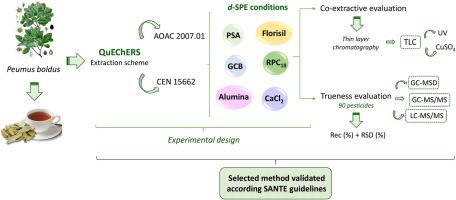Journal of Applied Research on Medicinal and Aromatic Plants ( IF 3.8 ) Pub Date : 2020-04-18 , DOI: 10.1016/j.jarmap.2020.100254 Britt Maestroni , Natalia Besil , Alejandra Bojorge , Natalia Gérez , Andrés Pérez-Parada , Andrew Cannavan , Horacio Heinzen , María V. Cesio

|
The QuEChERS methods, CEN 15662 and AOAC 2007.01, and different clean-up variations were applied to the determination of pesticide residues in Peumus boldus Molina leaves, using LC and GC coupled to single and tandem mass spectrometry. Boldo belongs to the class of medicinal and aromatic plants. Because of its complex chemical composition including terpene peroxides, alkaloids and phenolic acids at concentrations typically 100-fold higher than that of a possible contaminant, it is a very challenging matrix for pesticide residue determination. Thin layer chromatography was used to evaluate the efficacy of removal of matrix co-extractives using different clean-up sorbents, including neutral alumina, graphitized carbon black (GCB), octadecyl reverse phase silica gel (RP-C18) and pH modification in the extraction and clean-up steps. The most promising method was a combination of GCB, RP-C18 and primary-secondary amine (PSA) within the QuEChERS template. The final optimized method was validated according to the SANTE guidelines using LC–MS/MS and GC–MS/MS. The method scope includes 84 representative pesticide residues with recoveries ranging from 70 to 119% and within laboratory relative standard deviations below 15%. The method was initially validated for 25 representative pesticides using GC-MSD, making it applicable in those laboratories equipped only with a single mass detector. It is important to emphasize that the method complies with the requirements of international pharmacopoeias and food regulatory agencies, since herbal teas are found in both categories, as herbal remedies and foods.
中文翻译:

使用GC-MSD,GC-MS / MS和LC-MS / MS的单一方法测定和验证大果桑叶中农药残留的优化和验证
所述的QuEChERS方法,CEN 15662和AOAC 2007.01,和不同的清理变化分别适用于农药残留在确定Peumus boldus Molina的叶,使用LC和GC耦合到单个和串联质谱。波尔多(Boldo)属于药用和芳香植物类。由于其复杂的化学成分(包括萜烯过氧化物,生物碱和酚酸)的浓度通常比可能的污染物高100倍,因此对于农药残留的测定而言,这是一个非常具有挑战性的基质。薄层色谱法用于评估使用不同净化吸附剂(包括中性氧化铝,石墨化炭黑(GCB),十八烷基反相硅胶(RP-C 18))去除基质共萃取物的功效)和在萃取和净化步骤中进行pH调节。最有前途的方法是结合GCB,RP-C 18和QuEChERS模板中的伯仲胺(PSA)。根据SANTE指南,使用LC-MS / MS和GC-MS / MS验证了最终的优化方法。方法范围包括84种代表性农药残留,回收率在70%至119%之间,并且实验室相对标准偏差在15%以下。该方法最初使用GC-MSD对25种代表性农药进行了验证,使其适用于仅配备单个质量检测器的实验室。必须强调的是,该方法符合国际药典和食品管理机构的要求,因为在这两种类别中都发现了凉茶,作为草药和食品。










































 京公网安备 11010802027423号
京公网安备 11010802027423号